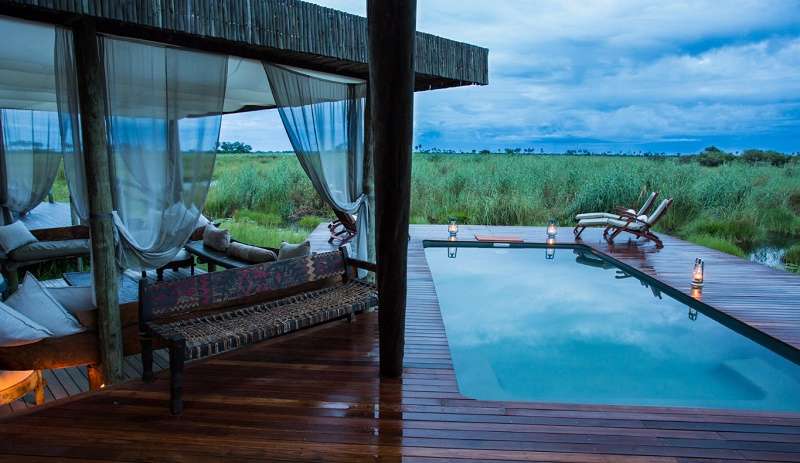Created by seasonal flooding. The river drains the summer rainfall from the highlands, and the surge flows for kilometres. The waters then spread over the region of the delta in over the next four months (March-June). The high temperature of the delta causes rapid transpiration and evaporation of the water, resulting in a cycle of rising & falling water heights. The flood peaks between June & August, dry winter months, the delta swells to three times its normal size, attracting animals from miles around and creating one of Africa’s greatest concentrations of wildlife.
The area is very flat, with less than 2 metres variation in height across its 15,010 km². Every year about 11 cubic kilometres of water flows into the area. About 60% of this water is consumed through transpiration by plants, 36% by evaporation, 2% percolates into the aquifer system while 2% flows into the lake. This turgid outflow means that the Okavango Delta is unable to flush out the minerals and will become increasingly salty and uninhabitable over time. This effect is reduced by low salt content which collects around the roots of plants. The low salinity of the water means that the floods do not significantly enrich the floodplain with nutrients.
Salt Islands
The agglomeration of salt around plant roots in the Okavango Delta results in many of the thousands of islands having barren white patches in their centre as they are too salty for plants, aside from odd palm tree.
Trees and grasses grow in the sand near the edges of the islands of the Okavango Delta that has yet to become too salty. About 70% of the islands began as termite mounds where a tree then takes root on the mound of earth.
Chief’s Island
Chief’s Island is the largest island in the Okavango Delta. Chief's Island was formed by a fault line which uplifted an area over 72 km long and 16 km wide. Historically an elite hunting area for the chief and now the area for much of the resident wildlife when the waters rise.
Wildlife
The delta is a permanent & seasonal home to a wide variety of wildlife. Animal species which can be found here:
- African Elephant
- African Buffalo
- Hippopotamus
- Lechwe
- Topi
- Blue Wildebeest
- Giraffe
- Nile Crocodile
- Lion,
- Cheetah,
- Leopard,
- Brown Hyena
- Spotted Hyena
- Greater Kudu
- Sable Antelope
- Black Rhinoceros
- White Rhinoceros
- Plains Zebra
- Warthog
- Chacma Baboon
The majority of the large mammals in and around the Okavango Delta are not year-round residents. They leave with the summer rains then make their way back as winter approaches. Large herds of buffalo and elephant total about 31,010 of them. The most populous large mammal is the lechwe antelope, with more than 61,000 of them. The Lechwe is a little bigger than an Impala and has a water-repellent substance on their legs which enables rapid movement through knee deep water. The Lechwe antelope graze on aquatic plants and, like Waterbuck, take to water when threatened by predators.
.jpg)
.jpg)
.jpg)


.jpg)

